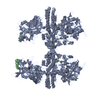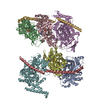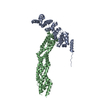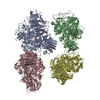+ データを開く
データを開く
- 基本情報
基本情報
| 登録情報 | データベース: PDB / ID: 2go5 | ||||||
|---|---|---|---|---|---|---|---|
| タイトル | Structure of signal recognition particle receptor (SR) in complex with signal recognition particle (SRP) and ribosome nascent chain complex | ||||||
 要素 要素 |
| ||||||
 キーワード キーワード | TRANSLATION/RNA / SR / SRP / RIBOSOME / TRANSLATION-RNA COMPLEX | ||||||
| 機能・相同性 |  機能・相同性情報 機能・相同性情報SRP-dependent cotranslational protein targeting to membrane / signal recognition particle receptor complex / SRP-dependent cotranslational protein targeting to membrane, signal sequence recognition / endoplasmic reticulum signal peptide binding / signal recognition particle, endoplasmic reticulum targeting / signal recognition particle binding / cotranslational protein targeting to membrane / granulocyte differentiation / protein targeting to ER / signal-recognition-particle GTPase ...SRP-dependent cotranslational protein targeting to membrane / signal recognition particle receptor complex / SRP-dependent cotranslational protein targeting to membrane, signal sequence recognition / endoplasmic reticulum signal peptide binding / signal recognition particle, endoplasmic reticulum targeting / signal recognition particle binding / cotranslational protein targeting to membrane / granulocyte differentiation / protein targeting to ER / signal-recognition-particle GTPase / SRP-dependent cotranslational protein targeting to membrane, translocation / XBP1(S) activates chaperone genes / 7S RNA binding / exocrine pancreas development / SRP-dependent cotranslational protein targeting to membrane / ribonucleoprotein complex binding / cytoplasmic microtubule / neutrophil chemotaxis / maturation of LSU-rRNA from tricistronic rRNA transcript (SSU-rRNA, 5.8S rRNA, LSU-rRNA) / chloroplast / intracellular protein transport / GDP binding / cytosolic large ribosomal subunit / rRNA binding / nuclear speck / structural constituent of ribosome / ribosome / translation / ribonucleoprotein complex / mRNA binding / GTPase activity / endoplasmic reticulum membrane / GTP binding / nucleolus / endoplasmic reticulum / ATP hydrolysis activity / RNA binding / extracellular exosome / nucleoplasm / nucleus / membrane / cytosol 類似検索 - 分子機能 | ||||||
| 生物種 |   Homo sapiens (ヒト) Homo sapiens (ヒト)  | ||||||
| 手法 | 電子顕微鏡法 / 単粒子再構成法 / クライオ電子顕微鏡法 / 解像度: 7.4 Å | ||||||
 データ登録者 データ登録者 | Halic, M. / Gartmann, M. / Schlenker, O. / Mielke, T. / Pool, M.R. / Sinning, I. / Beckmann, R. | ||||||
 引用 引用 |  ジャーナル: Science / 年: 2006 ジャーナル: Science / 年: 2006タイトル: Signal recognition particle receptor exposes the ribosomal translocon binding site. 著者: Mario Halic / Marco Gartmann / Oliver Schlenker / Thorsten Mielke / Martin R Pool / Irmgard Sinning / Roland Beckmann /  要旨: Signal sequences of secretory and membrane proteins are recognized by the signal recognition particle (SRP) as they emerge from the ribosome. This results in their targeting to the membrane by ...Signal sequences of secretory and membrane proteins are recognized by the signal recognition particle (SRP) as they emerge from the ribosome. This results in their targeting to the membrane by docking with the SRP receptor, which facilitates transfer of the ribosome to the translocon. Here, we present the 8 angstrom cryo-electron microscopy structure of a "docking complex" consisting of a SRP-bound 80S ribosome and the SRP receptor. Interaction of the SRP receptor with both SRP and the ribosome rearranged the S domain of SRP such that a ribosomal binding site for the translocon, the L23e/L35 site, became exposed, whereas Alu domain-mediated elongation arrest persisted. | ||||||
| 履歴 |
| ||||||
| Remark 999 | SEQUENCE Residue (A G 124) and Residue (A G 125) are not linked. Distance of O3*-P bond is 4.22. ...SEQUENCE Residue (A G 124) and Residue (A G 125) are not linked. Distance of O3*-P bond is 4.22. Residue (A C 221) and Residue (A G 222) are not linked. Distance of O3*-P bond is 3.26. Residue (1 SER 0) and Residue (1 MET 1) are not linked. Distance of C-N bond is 17.58. Residue (1 GLY 27) and Residue (1 PRO 28) are not linked. Distance of C-N bond is 7.21. Residue (1 LEU 52) and Residue (1 THR 53) are not linked. Distance of C-N bond is 5.58. |
- 構造の表示
構造の表示
| ムービー |
 ムービービューア ムービービューア |
|---|---|
| 構造ビューア | 分子:  Molmil Molmil Jmol/JSmol Jmol/JSmol |
- ダウンロードとリンク
ダウンロードとリンク
- ダウンロード
ダウンロード
| PDBx/mmCIF形式 |  2go5.cif.gz 2go5.cif.gz | 288.5 KB | 表示 |  PDBx/mmCIF形式 PDBx/mmCIF形式 |
|---|---|---|---|---|
| PDB形式 |  pdb2go5.ent.gz pdb2go5.ent.gz | 215.2 KB | 表示 |  PDB形式 PDB形式 |
| PDBx/mmJSON形式 |  2go5.json.gz 2go5.json.gz | ツリー表示 |  PDBx/mmJSON形式 PDBx/mmJSON形式 | |
| その他 |  その他のダウンロード その他のダウンロード |
-検証レポート
| 文書・要旨 |  2go5_validation.pdf.gz 2go5_validation.pdf.gz | 910.6 KB | 表示 |  wwPDB検証レポート wwPDB検証レポート |
|---|---|---|---|---|
| 文書・詳細版 |  2go5_full_validation.pdf.gz 2go5_full_validation.pdf.gz | 981.6 KB | 表示 | |
| XML形式データ |  2go5_validation.xml.gz 2go5_validation.xml.gz | 41.4 KB | 表示 | |
| CIF形式データ |  2go5_validation.cif.gz 2go5_validation.cif.gz | 61.7 KB | 表示 | |
| アーカイブディレクトリ |  https://data.pdbj.org/pub/pdb/validation_reports/go/2go5 https://data.pdbj.org/pub/pdb/validation_reports/go/2go5 ftp://data.pdbj.org/pub/pdb/validation_reports/go/2go5 ftp://data.pdbj.org/pub/pdb/validation_reports/go/2go5 | HTTPS FTP |
-関連構造データ
- リンク
リンク
- 集合体
集合体
| 登録構造単位 | 
|
|---|---|
| 1 |
|
- 要素
要素
-RNA鎖 , 2種, 2分子 A9
| #1: RNA鎖 | 分子量: 41199.570 Da / 分子数: 1 / 由来タイプ: 天然 / 由来: (天然)  |
|---|---|
| #2: RNA鎖 | 分子量: 29170.479 Da / 分子数: 1 / 由来タイプ: 天然 / 由来: (天然)  |
-Signal recognition particle ... , 4種, 4分子 BW12
| #3: タンパク質 | 分子量: 12561.688 Da / 分子数: 1 / 由来タイプ: 組換発現 / 由来: (組換発現)  |
|---|---|
| #4: タンパク質 | 分子量: 12473.440 Da / 分子数: 1 / 由来タイプ: 組換発現 / 由来: (組換発現)  |
| #5: タンパク質 | 分子量: 21329.512 Da / 分子数: 1 / 由来タイプ: 組換発現 / 由来: (組換発現)  Homo sapiens (ヒト) / 参照: UniProt: P08240 Homo sapiens (ヒト) / 参照: UniProt: P08240 |
| #6: タンパク質 | 分子量: 23536.982 Da / 分子数: 1 / 由来タイプ: 組換発現 / 由来: (組換発現)  |
-Ribosomal protein ... , 3種, 3分子 546
| #7: タンパク質 | 分子量: 14401.041 Da / 分子数: 1 / 由来タイプ: 組換発現 / 由来: (組換発現)  |
|---|---|
| #8: タンパク質 | 分子量: 16920.203 Da / 分子数: 1 / 由来タイプ: 組換発現 / 由来: (組換発現)  |
| #9: タンパク質 | 分子量: 14152.365 Da / 分子数: 1 / 由来タイプ: 組換発現 / 由来: (組換発現)  |
-詳細
| Has protein modification | Y |
|---|
-実験情報
-実験
| 実験 | 手法: 電子顕微鏡法 |
|---|---|
| EM実験 | 試料の集合状態: PARTICLE / 3次元再構成法: 単粒子再構成法 |
- 試料調製
試料調製
| 構成要素 | 名称: SR-SRP-RNC COMPLEX / タイプ: RIBOSOME |
|---|---|
| 試料 | 包埋: NO / シャドウイング: NO / 染色: NO / 凍結: YES |
| 試料支持 | 詳細: CARBON |
| 急速凍結 | 凍結剤: ETHANE |
- 電子顕微鏡撮影
電子顕微鏡撮影
| 実験機器 |  モデル: Tecnai F30 / 画像提供: FEI Company |
|---|---|
| 顕微鏡 | モデル: FEI TECNAI F30 |
| 電子銃 | 電子線源:  FIELD EMISSION GUN / 加速電圧: 300 kV / 照射モード: FLOOD BEAM FIELD EMISSION GUN / 加速電圧: 300 kV / 照射モード: FLOOD BEAM |
| 電子レンズ | モード: BRIGHT FIELD / 最大 デフォーカス(公称値): 3500 nm / 最小 デフォーカス(公称値): 800 nm |
| 撮影 | フィルム・検出器のモデル: KODAK SO-163 FILM |
| 放射 | プロトコル: SINGLE WAVELENGTH / 単色(M)・ラウエ(L): M |
| 放射波長 | 相対比: 1 |
- 解析
解析
| 対称性 | 点対称性: C1 (非対称) | ||||||||||||
|---|---|---|---|---|---|---|---|---|---|---|---|---|---|
| 3次元再構成 | 解像度: 7.4 Å / 解像度の算出法: FSC 0.5 CUT-OFF / 対称性のタイプ: POINT | ||||||||||||
| 精密化 | 最高解像度: 7.4 Å | ||||||||||||
| 精密化ステップ | サイクル: LAST / 最高解像度: 7.4 Å
|
 ムービー
ムービー コントローラー
コントローラー












 PDBj
PDBj
































